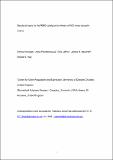Files in this item
Structural basis for the RING-catalyzed synthesis of K63-linked ubiquitin chains
Item metadata
| dc.contributor.author | Branigan, Emma | |
| dc.contributor.author | Plechanovová, Anna | |
| dc.contributor.author | Jaffray, Ellis | |
| dc.contributor.author | Naismith, Jim | |
| dc.contributor.author | Hay, Ronald Thomas | |
| dc.date.accessioned | 2016-01-06T00:12:21Z | |
| dc.date.available | 2016-01-06T00:12:21Z | |
| dc.date.issued | 2015-08 | |
| dc.identifier | 195818484 | |
| dc.identifier | ef003a5e-9d16-4236-abe0-4e4c01c591ed | |
| dc.identifier | 84938749159 | |
| dc.identifier | 000359177400003 | |
| dc.identifier.citation | Branigan , E , Plechanovová , A , Jaffray , E , Naismith , J & Hay , R T 2015 , ' Structural basis for the RING-catalyzed synthesis of K63-linked ubiquitin chains ' , Nature Structural and Molecular Biology , vol. 22 , no. 8 , pp. 597-602 . https://doi.org/10.1038/nsmb.3052 | en |
| dc.identifier.issn | 1545-9993 | |
| dc.identifier.uri | https://hdl.handle.net/10023/7973 | |
| dc.description | This work was supported by grants from Cancer Research UK (C434/A13067), the Wellcome Trust (098391/Z/12/Z) and Biotechnology and Biological Sciences Research Council (BB/J016004/1). | en |
| dc.description.abstract | The RING E3 ligase catalysed formation of lysine 63 linked ubiquitin chains by the Ube2V2–Ubc13 E2 complex is required for many important biological processes. Here we report the structure of the RING domain dimer of rat RNF4 in complex with a human Ubc13~Ub conjugate and Ube2V2. The structure has captured Ube2V2 bound to the acceptor (priming) ubiquitin with Lys63 in a position that could lead to attack on the linkage between the donor (second) ubiquitin and Ubc13 that is held in the active “folded back” conformation by the RING domain of RNF4. The interfaces identified in the structure were verified by in vitro ubiquitination assays of site directed mutants. This represents the first view of the synthesis of Lys63 linked ubiquitin chains in which both substrate ubiquitin and ubiquitin-loaded E2 are juxtaposed to allow E3 ligase mediated catalysis. | |
| dc.format.extent | 1273191 | |
| dc.language.iso | eng | |
| dc.relation.ispartof | Nature Structural and Molecular Biology | en |
| dc.subject | QD Chemistry | en |
| dc.subject | QR Microbiology | en |
| dc.subject | QH426 Genetics | en |
| dc.subject | NDAS | en |
| dc.subject.lcc | QD | en |
| dc.subject.lcc | QR | en |
| dc.subject.lcc | QH426 | en |
| dc.title | Structural basis for the RING-catalyzed synthesis of K63-linked ubiquitin chains | en |
| dc.type | Journal article | en |
| dc.contributor.institution | University of St Andrews. School of Chemistry | en |
| dc.contributor.institution | University of St Andrews. EaSTCHEM | en |
| dc.contributor.institution | University of St Andrews. Biomedical Sciences Research Complex | en |
| dc.contributor.institution | University of St Andrews. School of Biology | en |
| dc.identifier.doi | https://doi.org/10.1038/nsmb.3052 | |
| dc.description.status | Peer reviewed | en |
| dc.date.embargoedUntil | 2016-01-06 | |
| dc.identifier.url | http://www.nature.com/nsmb/journal/vaop/ncurrent/full/nsmb.3052.html#supplementary-information | en |
This item appears in the following Collection(s)
Items in the St Andrews Research Repository are protected by copyright, with all rights reserved, unless otherwise indicated.

